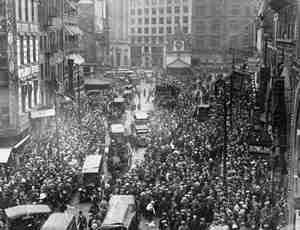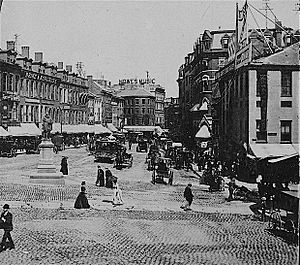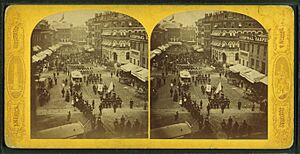Scollay Square facts for kids
Scollay Square was a lively city area in downtown Boston, Massachusetts. It existed from about 1838 until 1962. The square was named after William Scollay. He was a local builder and a militia officer. A militia is like a group of citizens who can act as soldiers.
William Scollay bought a large building in 1795. It was at the crossing of Cambridge and Court Streets. People started calling the area "Scollay's Square." In 1838, the city officially named it Scollay Square. At first, it was a busy place for businesses. Famous people worked there, like Josiah Johnson Hawes. He was a daguerreotypist, which is an early type of photographer. Dr. William T. G. Morton also worked there. He was the first dentist to use ether to make people sleep during surgery. This is called an anaesthetic.
By the 1950s, city leaders wanted to tear down Scollay Square. They planned to rebuild the whole area. More than 1,000 buildings were taken down. About 20,000 people had to move from their homes. The city used $40 million in government money. They built a new area called Government Center in its place.
History of Scollay Square
Scollay Square was located where Tremont and Court streets met. It was also near Cornhill and Tremont Row. The city first called it Pemberton Square. But then they changed the name to Scollay Square. This happened when another area, Phillips Square, changed its name to Pemberton Square.
The building that gave the area its name was Scollay's Building. It was the last part of a group of older wooden buildings. These buildings used to stretch from Cornhill to Hanover Street. An early schoolhouse was built there in 1683-84. Over time, parts of these buildings were removed. Only the brick Scollay building was left. It was built around 1795 and named for William Scollay. It was taken down around 1870.
A Place for Entertainment
One of the most famous places in Scollay Square was the Old Howard Theatre. It was a grand theater. It started as a church for a group called Millerites. They believed the world would end in October 1844. When the world did not end, the building was sold in 1844. It reopened as a vaudeville and Shakespeare theater. Vaudeville shows had many different acts, like singers, dancers, and comedians. Later, in the early 1900s, it showed popular minstrel shows.
Around the 1940s, Scollay Square became less busy. The Old Howard Theatre started showing burlesque shows. These shows were popular with sailors and college students. Other nearby places, like the Casino Theater, also showed burlesque. The Old Howard's slogan was "Always Something Doing." The theater also hosted boxing matches. Famous boxers like Rocky Marciano fought there. It still had funny slapstick acts. Groups like The Marx Brothers and Abbott and Costello performed there.
In 1953, the theater closed. It stayed closed until it caught fire in 1961. The square was also home to Austin and Stone's Dime Museum. This was a museum where you could see many interesting things for a small fee.
In 1880, a bronze statue of John Winthrop was put in the square. He was the first Governor of Massachusetts. The sculptor Richard Saltonstall Greenough made the statue.
A Hub for Change

Scollay Square was also important for the early abolition movement. This movement worked to end slavery. Author William Lloyd Garrison printed his anti-slavery newspaper, The Liberator, starting in 1831. He was attacked twice by angry crowds for his work.
In 1853, Sarah Parker Remond took a stand against unfair rules at the Old Howard. She bought a ticket for a good seat. But she was told to sit in the 'black' section because of racial segregation. Many buildings in Scollay Square had secret rooms. Escaped slaves hid there as part of the Underground Railroad. This was a network of safe places that helped slaves reach freedom.
The Square is Rebuilt
After World War II, Scollay Square became run-down. The Old Howard Theatre had become a very rough burlesque place.
By the 1950s, city leaders planned to tear down Scollay Square. They wanted to remove the older, troubled businesses. They also wanted to move lower-income residents. People tried to save the Old Howard Theatre. But after it burned down, the city began to demolish buildings. More than 1,000 buildings were torn down. About 20,000 people had to move.
The city offered the demolished materials for free. Anyone who could load a dump truck could take the materials. This included street paving blocks, granite, and bricks.
With $40 million from the government, the city built a new area. It was built on top of old Scollay Square. They renamed it Government Center. New government buildings were built there. These included Boston City Hall, City Hall Plaza, and the Edward W. Brooke Courthouse.






